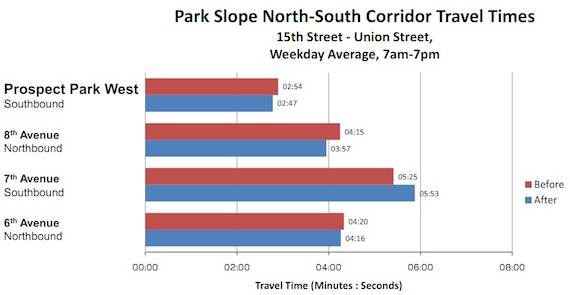
On the heels of Brad Lander's survey showing that a whopping 78 percent of interested Brooklyn residents want to keep the traffic calming Prospect Park West bike lane, DOT has released still more data [PDF] showing that the new street design keeps New Yorkers safer and helps them get where they're going.
With two more months of data collection since DOT last released its Prospect Park West numbers, the fundamental facts about the redesign remain. As DOT found in October, while three-quarters of cars were measured speeding before the redesign, now only one in six drive over the speed limit. The number of cyclists roughly tripled on weekdays, and doubled on weekends. There are some slight variations in the December numbers -- the more recent data show slightly higher speeds in the morning and slower speeds in the evening, for example -- but these effects are looking like they're here to stay.
The December numbers add new evidence that, contrary to opponents' claims, the narrower Prospect Park West has not caused congestion. Looking at travel times, DOT shows that even though speeding is down, a trip down Prospect Park West actually takes a few seconds under the new design. Travel times are slightly down on Eighth and Sixth Avenues as well, though a bit up on Seventh. Even during rush hour, the effects on vehicle speeds are negligible, with morning peak car trips taking a few seconds longer and evening peak trips taking a few seconds shorter.
Finally, DOT has now released a count of the total number of commuters using Prospect Park West. By turning one vehicular lane into a two-way bike lane, they were able to increase the number of people using the street. The combined count of motor vehicles and bikes increased by 11 percent in the morning and six percent in the afternoon. It's a perfect illustration of a concept that's central to PlaNYC: We're going to need to prioritize sustainable transportation for one million more New Yorkers to fit on our crowded streets without making traffic even worse.






